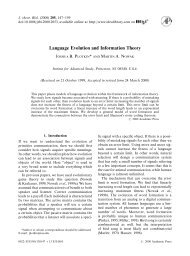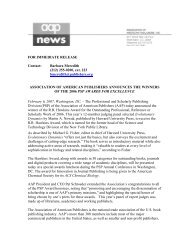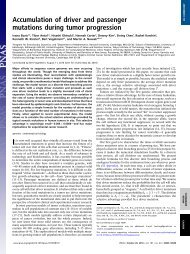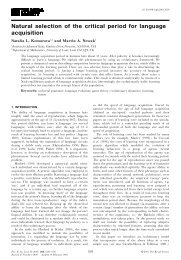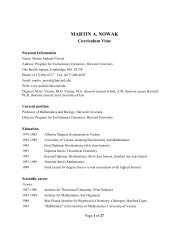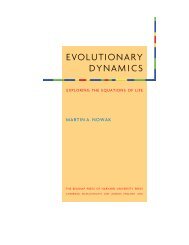Dr. Folkman's War: Angiogenesis and the Struggle to Defeat Cancer ...
Dr. Folkman's War: Angiogenesis and the Struggle to Defeat Cancer ...
Dr. Folkman's War: Angiogenesis and the Struggle to Defeat Cancer ...
You also want an ePaper? Increase the reach of your titles
YUMPU automatically turns print PDFs into web optimized ePapers that Google loves.
© 2001 Nature Publishing Group http://medicine.nature.com<br />
BOOK REVIEW<br />
© 2001 Nature Publishing Group http://medicine.nature.com<br />
<strong>Dr</strong>. Folkman’s <strong>War</strong>:<br />
<strong>Angiogenesis</strong> <strong>and</strong> <strong>the</strong><br />
<strong>Struggle</strong> <strong>to</strong> <strong>Defeat</strong><br />
<strong>Cancer</strong><br />
By Robert Cooke<br />
R<strong>and</strong>om House, 365 pp, $25.95<br />
ISBN: 0375502440, 2001<br />
REVIEWED BY ROBERT BUCKMAN<br />
University of Toron<strong>to</strong><br />
Toron<strong>to</strong>, Ontario, Canada<br />
The life <strong>and</strong> work of Judah Folkman make a<br />
fascinating s<strong>to</strong>ry. There is an old saying <strong>to</strong><br />
<strong>the</strong> effect that truth is like daylight shining<br />
behind a curtain which has many pinholes—how<br />
much you see doesn’t depend<br />
on which hole you decide <strong>to</strong> look through,<br />
but on how close <strong>to</strong> <strong>the</strong> curtain you get<br />
your eye. Judah Folkman, in a research career<br />
spanning <strong>the</strong> last three decades, has<br />
clearly got very close <strong>to</strong> <strong>the</strong> curtain indeed.<br />
Extraordinarily, he arrived in cancer research<br />
after starting in a <strong>to</strong>tally<br />
different area. The<br />
research that eventually<br />
moved <strong>to</strong>wards angiogenesis<br />
actually began as a project investigating<br />
<strong>the</strong> damage sustained<br />
by erythrocytes as <strong>the</strong>y<br />
circulated through a pro<strong>to</strong>type<br />
heart-lung machine. This<br />
was perhaps a ra<strong>the</strong>r unpromising<br />
pinhole <strong>to</strong> start<br />
peering through, but this book<br />
meticulously chronicles <strong>and</strong><br />
clearly explains every step<br />
from that project, <strong>to</strong> his current<br />
research which has far-reaching implications<br />
for <strong>the</strong> way cancers are treated.<br />
Folkman wanted <strong>to</strong> find out why natural<br />
blood vessels caused less damage than<br />
metal tubes, <strong>and</strong> <strong>to</strong> do that he needed a<br />
way of looking at blood vessels. That got<br />
him interested in what makes blood vessels<br />
grow <strong>and</strong> what s<strong>to</strong>ps <strong>the</strong>m from growing,<br />
<strong>and</strong> by that time—from what we learn of<br />
his personality—his attention was fully engaged.<br />
At times <strong>the</strong> s<strong>to</strong>ry reads almost like science<br />
fiction, being somewhat reminiscent<br />
of Kurt Vonnegut’s creation Felix<br />
Hoenikker: <strong>the</strong> physicist who invents “ice-<br />
9” (a form of ice that is solid at room temperature)<br />
because he wants <strong>to</strong> help soldiers<br />
walk through mud, <strong>and</strong> freezing <strong>the</strong> mud<br />
seems a good solution. Folkman was clearly<br />
capable of that type of thinking <strong>and</strong> he<br />
showed, even early in his career, a rare ability<br />
<strong>to</strong> back up his thoughts <strong>and</strong> ideas with<br />
<strong>the</strong> dogged persistence <strong>to</strong> put in <strong>the</strong> hours,<br />
months <strong>and</strong> years <strong>to</strong> get a reliable answer.<br />
Folkman’s research in<strong>to</strong> <strong>the</strong> mechanisms<br />
involved in tumor-induced angiogenesis<br />
has changed many fundamental aspects of<br />
<strong>the</strong> way we think about tumor growth, <strong>and</strong><br />
ways in which that growth might be controlled.<br />
Perhaps it was inevitable that his<br />
ideas, running counter <strong>to</strong> orthodox thinking,<br />
should at first have been dismissed.<br />
But his<strong>to</strong>ry has changed prevailing attitudes.<br />
Folkman’s work has in many respects<br />
now filled <strong>the</strong> breach created by <strong>the</strong><br />
failure of high-dose chemo<strong>the</strong>rapy (with<br />
au<strong>to</strong>logous marrow or stem-cell support) <strong>to</strong><br />
cure most common solid tumors. During<br />
<strong>the</strong> 1980s <strong>and</strong> most of <strong>the</strong> 1990s when<br />
eradication of every last tumor stem-cell<br />
seemed <strong>the</strong> only way <strong>to</strong> prolong patient<br />
survival, it was not surprising that so few<br />
people were genuinely interested in tumor<br />
vasculature. Now that ‘more-is-better’ is no<br />
longer inviolable dogma, <strong>the</strong> world is turning<br />
its attention <strong>to</strong> Folkman’s suggestion<br />
that tumor vasculature might be a far more<br />
suitable target for <strong>the</strong>rapy,<br />
which might need <strong>to</strong> be administered<br />
virtually continuously<br />
ra<strong>the</strong>r than as<br />
periodic <strong>and</strong> sometimes<br />
highly <strong>to</strong>xic doses.<br />
What makes this book<br />
even more interesting for<br />
researchers <strong>and</strong> clinicians<br />
alike is <strong>the</strong> degree of detail,<br />
including <strong>the</strong> naming of<br />
names. Robert Cooke, a<br />
well-known science journalist,<br />
gives <strong>the</strong> reader a<br />
blow-by-blow account of<br />
<strong>the</strong> research projects <strong>the</strong>mselves <strong>and</strong> of <strong>the</strong><br />
accompanying difficulties in grant funding,<br />
publication <strong>and</strong> partnerships with<br />
pharmaceutical <strong>and</strong> biological manufacturers.<br />
Two things will impress any researcher<br />
who reads this. First, even a major figure<br />
like Folkman had years of rejection—when<br />
his grants were turned down <strong>and</strong> some of<br />
his colleagues treated him as a pariah.<br />
Second, partnerships between academia<br />
<strong>and</strong> industry are fraught with traps, ambushes<br />
<strong>and</strong> reverses. I found myself as<strong>to</strong>unded<br />
at how Folkman was able <strong>to</strong><br />
survive <strong>and</strong> function despite so many projects<br />
that didn’t turn out as hoped, rejections<br />
from funding agencies for some that<br />
had, <strong>and</strong> tussles with <strong>the</strong> various hierarchies<br />
of academic institutions <strong>and</strong> major<br />
companies.<br />
On <strong>to</strong>p of all that, <strong>the</strong>re is <strong>the</strong> small matter<br />
of public relations. The world at large<br />
first heard of Judah Folkman’s work in<br />
1998 when <strong>the</strong> New York Times ran a frontpage<br />
headline that was only a hairsbreadth<br />
away from <strong>the</strong> ‘major breakthrough’<br />
cliché. It was based on a conversation with<br />
Nobel laureate James D. Watson who had<br />
said, informally, that Folkman would cure<br />
cancer in two years. Folkman has always<br />
had a reputation—completely justified in<br />
<strong>the</strong> view of all those who have heard him<br />
lecture—for enthusiasm <strong>and</strong> clarity. But,<br />
unlike a few cancer researchers, he has always<br />
resisted far-fetched speculations <strong>and</strong><br />
any ‘all-we-need-<strong>to</strong>-do-is’ proclamations,<br />
<strong>and</strong> he has been careful <strong>and</strong> thoughtful in<br />
describing <strong>the</strong> implications of his work. To<br />
someone who always put so much care <strong>and</strong><br />
thought in<strong>to</strong> his statements, <strong>the</strong> New York<br />
Times headline must have been like a<br />
bomb. The whole s<strong>to</strong>ry of that episode,<br />
clearly <strong>and</strong> neatly explained in this book, is<br />
a valuable manual for any scientist trying<br />
<strong>to</strong> h<strong>and</strong>le <strong>the</strong> media—<strong>and</strong> it shows that<br />
things can get out of h<strong>and</strong> even when you<br />
stick <strong>to</strong> all <strong>the</strong> rules yourself.<br />
Regarding <strong>the</strong> future <strong>and</strong> <strong>the</strong> import of<br />
Folkman’s work, it is only rarely that one<br />
can agree with blurbs on <strong>the</strong> back jacket—<br />
especially if <strong>the</strong>y are headed ‘advance<br />
praise’. But when MIT’s Robert Weinberg<br />
says that Folkman’s ideas will “one day dramatically<br />
change cancer <strong>the</strong>rapy,” my<br />
guess is that he is right.<br />
Virus Dynamics:<br />
Ma<strong>the</strong>matical<br />
Principles of<br />
Immunology <strong>and</strong><br />
Virology<br />
by Martin A. Nowak &<br />
Robert M. May<br />
Oxford Press, 237 pp, $70.00<br />
hardcover/$34.95 paperback<br />
ISBN: 0198504179, 2000<br />
REVIEWED BY SIMON WAIN-HOBSON<br />
Unité de Rétrovirologie Moléculaire<br />
Institut Pasteur, Paris, France<br />
When disciplines clash <strong>the</strong>re are bound<br />
<strong>to</strong> be upheavals. Speaking of discipline,<br />
it’s pretty obvious that biology is in need<br />
of a bit. Our blackboards full of circles<br />
<strong>and</strong> arrows are ra<strong>the</strong>r <strong>to</strong>o easy<br />
metaphors. Genomics <strong>and</strong> proteomics<br />
have increased <strong>the</strong> number of variables<br />
NATURE MEDICINE • VOLUME 7 • NUMBER 5 • MAY 2001 525
BOOK REVIEW<br />
© 2001 Nature Publishing Group http://medicine.nature.com<br />
© 2001 Nature Publishing Group http://medicine.nature.com<br />
that biologists must h<strong>and</strong>le. Now, try<br />
some realpolitik: HIV invading <strong>the</strong> immune<br />
system with antigen-specific immune<br />
responses kicking in within days,<br />
<strong>the</strong> virus preying on <strong>the</strong> very T helper<br />
cells needed <strong>to</strong> orchestrate immune response,<br />
persistence despite ferocious immune<br />
responses, <strong>and</strong> genetic variation<br />
like we’ve never seen before. The immune<br />
system behaves not like a wellmixed<br />
Erlenmeyer flask, but ra<strong>the</strong>r as a<br />
highly delocalized ensemble of clonal<br />
sites that <strong>to</strong>ge<strong>the</strong>r make <strong>the</strong> famous polyclonal<br />
response. Studying such complexity<br />
requires solid data <strong>and</strong> analyses.<br />
Martin Nowak <strong>and</strong> Bob May have<br />
spent many years modeling <strong>the</strong> dynamics<br />
of this devastating viral infection.<br />
HIV is <strong>the</strong> Big One, measuring a 9 on<br />
<strong>the</strong> virological Richter scale.<br />
Accordingly, Nowak <strong>and</strong> May take <strong>the</strong><br />
problem head on, making few concessions<br />
<strong>to</strong> <strong>the</strong> unwary reader—<strong>the</strong> subtitle<br />
says it all, <strong>the</strong> ma<strong>the</strong>matical principles<br />
of immunology <strong>and</strong> virology. Let’s put<br />
it this way, <strong>the</strong> book contains more<br />
than a h<strong>and</strong>ful of equations.<br />
The modern era of viral dynamics<br />
dawned in January 1995, marked by two<br />
highly referenced papers that described<br />
<strong>the</strong> effect of powerful anti-HIV protease<br />
inhibi<strong>to</strong>rs in combination with extant<br />
anti-reverse transcriptase drugs. Plasma<br />
viremia was moni<strong>to</strong>red by quantitative<br />
PCR, Ah! PCR again, where would we be<br />
without Taq polymerase? Within days of<br />
treatment, plasma viremia was knocked<br />
down 2 <strong>to</strong> 3 logs. By applying a zest of<br />
analysis, <strong>the</strong> titanic struggle between <strong>the</strong><br />
virus <strong>and</strong> <strong>the</strong> host responses became immediately<br />
obvious. Questions such as<br />
what are <strong>the</strong> half-lives of productively infected<br />
cells <strong>and</strong> plasma viremia could<br />
now be addressed. Retrospectively it is<br />
clear that telltale signs came before, but<br />
combination <strong>the</strong>rapy was <strong>the</strong> seminal<br />
advance. For <strong>the</strong> record, ‘pre-modern’<br />
viral dynamics goes back <strong>to</strong> <strong>the</strong> late<br />
1950s with <strong>the</strong> determination of halflives<br />
of perfused virus in peripheral<br />
blood. Elegant stuff by <strong>the</strong> way.<br />
Nowak <strong>and</strong> May cover all <strong>the</strong> major<br />
areas of interest of HIV dynamics, including<br />
<strong>the</strong> emergence of drug resistance,<br />
cell-mediated immune responses (antibodies<br />
are barely mentioned), some<br />
minutiae of quasispecies <strong>and</strong> so forth,<br />
much of which is excellent. There is a<br />
model for all seasons, <strong>and</strong> variations on a<br />
<strong>the</strong>me, which are occasionally ra<strong>the</strong>r<br />
sparingly explained for <strong>the</strong> biologist, follow<br />
in a rapid succession. The book is entitled<br />
viral dynamics, <strong>and</strong> included are<br />
interesting data from hepatitis B virus<br />
worthy of comment, although no allusion<br />
is made <strong>to</strong> hepatitis C virus.<br />
The control of viremia by combination<br />
<strong>the</strong>rapy or by virus-specific cy<strong>to</strong><strong>to</strong>xic T<br />
lymphocytes (CTL) is a fascinating comparison.<br />
Using multiple drugs <strong>to</strong> hold<br />
down HIV is based on <strong>the</strong><br />
idea that <strong>the</strong> probability of<br />
finding a mutant simultaneously<br />
resistant <strong>to</strong> three<br />
drugs is less than for two,<br />
<strong>and</strong> four drugs less than for<br />
three, <strong>and</strong> so on. If <strong>the</strong><br />
probability is less than <strong>the</strong><br />
inverse of HIV population<br />
size in <strong>the</strong> body, <strong>the</strong> virus<br />
can’t out-maneuver <strong>the</strong><br />
drugs. When it comes <strong>to</strong> escape<br />
from CTL, <strong>the</strong> same<br />
rule applies—tie down<br />
Gulliver with as many<br />
ropes as possible. This is so efficient a<br />
strategy that <strong>the</strong> number of convincing<br />
cases of CTL-escape is trivially small.<br />
Indeed, presenting peptide epi<strong>to</strong>pes with<br />
polymorphic molecules is a marvelous<br />
way of dealing with viruses that mutate<br />
approximately one million times faster<br />
than <strong>the</strong>ir hosts.<br />
How well do Nowak <strong>and</strong> May succeed?<br />
Let’s back up one on viral dynamics <strong>and</strong><br />
first look at viral quasispecies, which preceded<br />
viral dynamics. Although modeled<br />
precisely on, <strong>and</strong> of relevance <strong>to</strong>, viruses<br />
cultured ex vivo, <strong>the</strong> concept of viral quasispecies<br />
has not helped advance our in<br />
vivo underst<strong>and</strong>ing. Instead, it has become<br />
little more than a euphemism for<br />
genetic heterogeneity. Back <strong>to</strong> dynamics.<br />
Looking at <strong>the</strong> profusion of equations I<br />
ran, not only for cover, but <strong>to</strong> try <strong>to</strong> work<br />
out what some of <strong>the</strong> terms might correspond<br />
<strong>to</strong> in <strong>the</strong> real world of lymphoid<br />
organs. Again, <strong>the</strong> immune system is not<br />
a well-stirred Erlenmeyer flask—oligoclonal<br />
foci are legion. Antigenic stimulation<br />
of latently HIV-infected T cells<br />
occurs locally. This introduces a s<strong>to</strong>chastic<br />
fac<strong>to</strong>r in<strong>to</strong> <strong>the</strong> amplification of HIV<br />
genotypes, for expansion of <strong>the</strong> variant<br />
harbored by a cell has nothing <strong>to</strong> do with<br />
<strong>the</strong> intrinsic fitness of <strong>the</strong> variant. With<br />
an extraordinary rate of viral recombination<br />
(2–3 crossovers per cycle!), multiply<br />
infected cells, phenomenal turnover of<br />
virions <strong>and</strong> destruction of infected cells<br />
that must result in strong bottlenecking,<br />
how is genotype (fitness) conserved?<br />
Spatial discontinuities may be hard <strong>to</strong><br />
h<strong>and</strong>le ma<strong>the</strong>matically, but in <strong>the</strong> case<br />
of <strong>the</strong> immune system it<br />
is a trademark.<br />
It is not yet obvious<br />
that <strong>the</strong> modeling of HIV<br />
dynamics has profoundly<br />
changed our ideas of HIV<br />
pathogenesis. The virologists<br />
<strong>and</strong> <strong>the</strong>ir clinical colleagues<br />
are still <strong>the</strong><br />
trailblazers. Yet it is easy<br />
<strong>to</strong> break along party lines,<br />
with <strong>the</strong> biologists bemoaning<br />
<strong>the</strong> complexity<br />
of <strong>the</strong> ma<strong>the</strong>matics <strong>and</strong><br />
simplifying assumptions,<br />
yet making no effort <strong>the</strong>mselves <strong>to</strong> grapple<br />
with <strong>the</strong> discipline necessary <strong>to</strong> h<strong>and</strong>ling<br />
numerous variables. On <strong>the</strong> o<strong>the</strong>r<br />
side, <strong>the</strong> ma<strong>the</strong>maticians may applaud<br />
<strong>the</strong> foray of <strong>the</strong>ir own in<strong>to</strong> something as<br />
extraordinarily complex as virology. The<br />
pathologist might well remark on <strong>the</strong> exquisite<br />
spatial architecture of a lymph<br />
node, <strong>and</strong> note dryly that pathogenesis<br />
cannot be unders<strong>to</strong>od by <strong>the</strong> molecular<br />
biologist working with tissue culture<br />
alone. Point.<br />
As <strong>the</strong> virological, immunological <strong>and</strong><br />
ma<strong>the</strong>matical plates become interlocked<br />
<strong>the</strong>re are bound <strong>to</strong> be shocks <strong>and</strong> shakeups.<br />
This book is a good move in <strong>the</strong><br />
right direction. It made me think about<br />
HIV pathogenesis. Early on in <strong>the</strong> book<br />
Nowak <strong>and</strong> May make a plea for discipline<br />
<strong>and</strong> responsibility in thought. The<br />
next time I use circle <strong>and</strong> arrow<br />
metaphors I’ll know who will be looking<br />
over my shoulder.<br />
526 NATURE MEDICINE • VOLUME 7 • NUMBER 5 • MAY 2001




